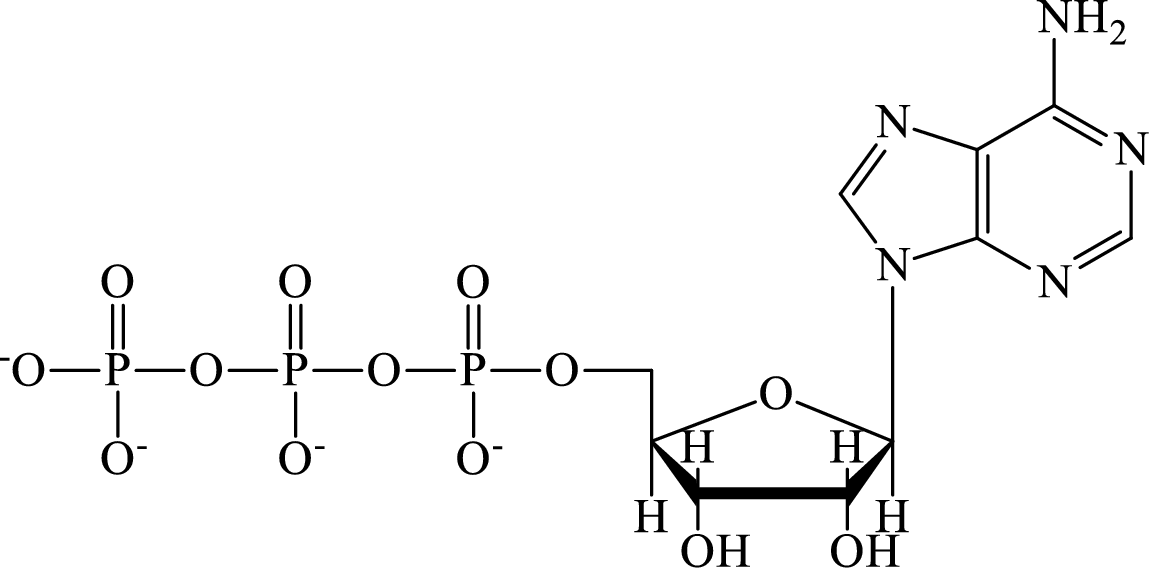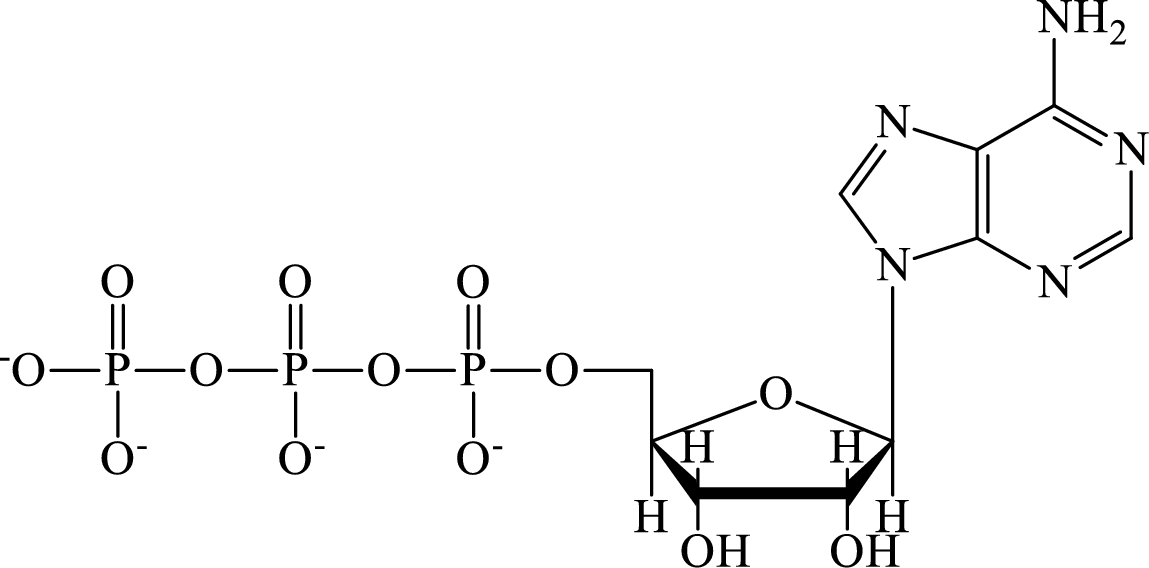
GENERAL,ORGANIC,+BIO.CHEM.-MINDTAP
7th Edition
ISBN: 9781305866966
Author: STOKER
Publisher: CENGAGE L
expand_more
expand_more
format_list_bulleted
Concept explainers
Question
Chapter 23, Problem 23.116EP
(a)
Interpretation Introduction
Interpretation: To determine the reactants in oxidative phosphorylation.
Concept introduction: Oxidative phosphorylation is the biochemical process for the synthesis of ATP from ADP and
The structure of ATP is:

(b)
Interpretation Introduction
Interpretation: To determine the products in oxidative phosphorylation.
Concept introduction: Oxidative phosphorylation is the biochemical process for the synthesis of ATP from ADP and
The structure of ATP is:

Expert Solution & Answer
Want to see the full answer?
Check out a sample textbook solution
Students have asked these similar questions
Provide the missing information. *see image
Why does the following reaction lead to poor yields? Correct the reaction. *see image
Provide the missing information. *see image
Chapter 23 Solutions
GENERAL,ORGANIC,+BIO.CHEM.-MINDTAP
Ch. 23.1 - Prob. 1QQCh. 23.1 - Prob. 2QQCh. 23.2 - Which of the following is not found within the...Ch. 23.2 - Which of the following is not an organelle? a....Ch. 23.2 - Prob. 3QQCh. 23.2 - Prob. 4QQCh. 23.3 - Which of the following statements concerning...Ch. 23.3 - Prob. 2QQCh. 23.3 - Which of the following statements concerning...Ch. 23.3 - Which of the following statements concerning...
Ch. 23.3 - Which of the following statements concerning...Ch. 23.4 - Prob. 1QQCh. 23.4 - Prob. 2QQCh. 23.5 - Prob. 1QQCh. 23.5 - Prob. 2QQCh. 23.5 - Prob. 3QQCh. 23.6 - Which of the following occurs in the second stage...Ch. 23.6 - Which of the following stages in the biochemical...Ch. 23.6 - Prob. 3QQCh. 23.7 - Prob. 1QQCh. 23.7 - Prob. 2QQCh. 23.7 - Prob. 3QQCh. 23.7 - How many NADH and FADH2 molecules are produced,...Ch. 23.7 - Which of the following citric acid cycle...Ch. 23.7 - In which of the following listings of citric acid...Ch. 23.8 - Which of the following is a fuel for the electron...Ch. 23.8 - Prob. 2QQCh. 23.8 - What is the substrate that initially interacts...Ch. 23.8 - The number of fixed enzyme sites in the electron...Ch. 23.8 - In which of the following listings of electron...Ch. 23.8 - Prob. 6QQCh. 23.9 - How many of the four enzyme complexes in the...Ch. 23.9 - Prob. 2QQCh. 23.9 - Prob. 3QQCh. 23.10 - Prob. 1QQCh. 23.10 - Prob. 2QQCh. 23.11 - Prob. 1QQCh. 23.11 - Prob. 2QQCh. 23.11 - Prob. 3QQCh. 23.12 - Prob. 1QQCh. 23.12 - Prob. 2QQCh. 23 - Classify anabolism and catabolism as synthetic or...Ch. 23 - Classify anabolism and catabolism as...Ch. 23 - What is a metabolic pathway?Ch. 23 - Prob. 23.4EPCh. 23 - Classify each of the following processes as...Ch. 23 - Classify each of the following processes as...Ch. 23 - Prob. 23.7EPCh. 23 - Prob. 23.8EPCh. 23 - Prob. 23.9EPCh. 23 - Indicate whether each of the following statements...Ch. 23 - Prob. 23.11EPCh. 23 - Prob. 23.12EPCh. 23 - Prob. 23.13EPCh. 23 - Prob. 23.14EPCh. 23 - Specify, by name and by number present, the...Ch. 23 - Prob. 23.16EPCh. 23 - Prob. 23.17EPCh. 23 - Prob. 23.18EPCh. 23 - Prob. 23.19EPCh. 23 - Prob. 23.20EPCh. 23 - Prob. 23.21EPCh. 23 - Prob. 23.22EPCh. 23 - Write a generalized chemical equation, containing...Ch. 23 - Prob. 23.24EPCh. 23 - Prob. 23.25EPCh. 23 - Prob. 23.26EPCh. 23 - Draw each of the following types of block diagrams...Ch. 23 - Prob. 23.28EPCh. 23 - What is the name of the B vitamin present in each...Ch. 23 - Prob. 23.30EPCh. 23 - Prob. 23.31EPCh. 23 - Prob. 23.32EPCh. 23 - Prob. 23.33EPCh. 23 - Prob. 23.34EPCh. 23 - Prob. 23.35EPCh. 23 - Prob. 23.36EPCh. 23 - Prob. 23.37EPCh. 23 - Prob. 23.38EPCh. 23 - Prob. 23.39EPCh. 23 - Prob. 23.40EPCh. 23 - Prob. 23.41EPCh. 23 - Prob. 23.42EPCh. 23 - Prob. 23.43EPCh. 23 - Prob. 23.44EPCh. 23 - Prob. 23.45EPCh. 23 - Prob. 23.46EPCh. 23 - Prob. 23.47EPCh. 23 - Prob. 23.48EPCh. 23 - Prob. 23.49EPCh. 23 - Prob. 23.50EPCh. 23 - Prob. 23.51EPCh. 23 - Prob. 23.52EPCh. 23 - Prob. 23.53EPCh. 23 - Prob. 23.54EPCh. 23 - Prob. 23.55EPCh. 23 - Prob. 23.56EPCh. 23 - Prob. 23.57EPCh. 23 - Prob. 23.58EPCh. 23 - List, by name, the four general stages of the...Ch. 23 - Prob. 23.60EPCh. 23 - Prob. 23.61EPCh. 23 - Prob. 23.62EPCh. 23 - Prob. 23.63EPCh. 23 - Prob. 23.64EPCh. 23 - Prob. 23.65EPCh. 23 - Prob. 23.66EPCh. 23 - Prob. 23.67EPCh. 23 - Prob. 23.68EPCh. 23 - Prob. 23.69EPCh. 23 - Prob. 23.70EPCh. 23 - Prob. 23.71EPCh. 23 - Prob. 23.72EPCh. 23 - Prob. 23.73EPCh. 23 - Prob. 23.74EPCh. 23 - Prob. 23.75EPCh. 23 - Prob. 23.76EPCh. 23 - Prob. 23.77EPCh. 23 - Prob. 23.78EPCh. 23 - Prob. 23.79EPCh. 23 - Prob. 23.80EPCh. 23 - Prob. 23.81EPCh. 23 - Prob. 23.82EPCh. 23 - Prob. 23.83EPCh. 23 - Prob. 23.84EPCh. 23 - Prob. 23.85EPCh. 23 - Prob. 23.86EPCh. 23 - Prob. 23.87EPCh. 23 - Prob. 23.88EPCh. 23 - Indicate whether each of the following changes...Ch. 23 - Prob. 23.90EPCh. 23 - Prob. 23.91EPCh. 23 - Prob. 23.92EPCh. 23 - Which electron carrier shuttles electrons between...Ch. 23 - Prob. 23.94EPCh. 23 - Prob. 23.95EPCh. 23 - Prob. 23.96EPCh. 23 - Prob. 23.97EPCh. 23 - Prob. 23.98EPCh. 23 - Prob. 23.99EPCh. 23 - Prob. 23.100EPCh. 23 - Put the following substances in the correct order...Ch. 23 - Prob. 23.102EPCh. 23 - Prob. 23.103EPCh. 23 - Prob. 23.104EPCh. 23 - Prob. 23.105EPCh. 23 - Prob. 23.106EPCh. 23 - Prob. 23.107EPCh. 23 - Prob. 23.108EPCh. 23 - Prob. 23.109EPCh. 23 - Prob. 23.110EPCh. 23 - How many protons cross the inner mitochondrial...Ch. 23 - How many protons cross the inner mitochondrial...Ch. 23 - Prob. 23.113EPCh. 23 - Prob. 23.114EPCh. 23 - Prob. 23.115EPCh. 23 - Prob. 23.116EPCh. 23 - Prob. 23.117EPCh. 23 - Prob. 23.118EPCh. 23 - Prob. 23.119EPCh. 23 - Prob. 23.120EPCh. 23 - Prob. 23.121EPCh. 23 - Prob. 23.122EPCh. 23 - Prob. 23.123EPCh. 23 - Prob. 23.124EPCh. 23 - Prob. 23.125EPCh. 23 - Prob. 23.126EPCh. 23 - Prob. 23.127EPCh. 23 - Prob. 23.128EPCh. 23 - Indicate whether or not each of the following B...Ch. 23 - Prob. 23.130EPCh. 23 - Prob. 23.131EPCh. 23 - Prob. 23.132EP
Knowledge Booster
Learn more about
Need a deep-dive on the concept behind this application? Look no further. Learn more about this topic, chemistry and related others by exploring similar questions and additional content below.Similar questions
- Draw the mechanism (including all curved arrows for electron movement) showing how the maleicanhydride is attacked by the anthracene and formation of the final Diels Alder product.arrow_forwardProvide the missing information. *see imagearrow_forwardProvide the missing information. *see imagearrow_forward
- Provide the missing information. *see imagearrow_forwardI have a bottle of butanal that has been improperly used by lab workers. They allowed a traceamount NaOH (aq) to contaminate the bottle. What is now in my bottle of “butanal? What is the molecular name and functional group name? Draw the structure.arrow_forwardProvide the missing information. *see imagearrow_forward
- First image: Why can't the molecule C be formed in those conditions Second image: Synthesis for lactone C its not an examarrow_forwardFirst image: I have to show the mecanism for the reaction on the left, where the alcohol A is added fast in one portion Second image: I have to show the mecanism of the reaction at the bottom. Also I have to show by mecanism why the reaction wouldn't work if the alcohol was primaryarrow_forwardFirst image: I have to explain why the molecule C is never formed in those conditions. Second image: I have to propose a synthesis for the lactone Aarrow_forward
arrow_back_ios
SEE MORE QUESTIONS
arrow_forward_ios
Recommended textbooks for you
 General, Organic, and Biological ChemistryChemistryISBN:9781285853918Author:H. Stephen StokerPublisher:Cengage Learning
General, Organic, and Biological ChemistryChemistryISBN:9781285853918Author:H. Stephen StokerPublisher:Cengage Learning Organic And Biological ChemistryChemistryISBN:9781305081079Author:STOKER, H. Stephen (howard Stephen)Publisher:Cengage Learning,
Organic And Biological ChemistryChemistryISBN:9781305081079Author:STOKER, H. Stephen (howard Stephen)Publisher:Cengage Learning, Chemistry for Today: General, Organic, and Bioche...ChemistryISBN:9781305960060Author:Spencer L. Seager, Michael R. Slabaugh, Maren S. HansenPublisher:Cengage Learning
Chemistry for Today: General, Organic, and Bioche...ChemistryISBN:9781305960060Author:Spencer L. Seager, Michael R. Slabaugh, Maren S. HansenPublisher:Cengage Learning

General, Organic, and Biological Chemistry
Chemistry
ISBN:9781285853918
Author:H. Stephen Stoker
Publisher:Cengage Learning

Organic And Biological Chemistry
Chemistry
ISBN:9781305081079
Author:STOKER, H. Stephen (howard Stephen)
Publisher:Cengage Learning,

Chemistry for Today: General, Organic, and Bioche...
Chemistry
ISBN:9781305960060
Author:Spencer L. Seager, Michael R. Slabaugh, Maren S. Hansen
Publisher:Cengage Learning
